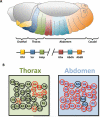Programmed cell death acts at different stages of Drosophila neurodevelopment to shape the central nervous system
- PMID: 27404003
- PMCID: PMC4983237
- DOI: 10.1002/1873-3468.12298
Programmed cell death acts at different stages of Drosophila neurodevelopment to shape the central nervous system
Abstract
Nervous system development is a process that integrates cell proliferation, differentiation, and programmed cell death (PCD). PCD is an evolutionary conserved mechanism and a fundamental developmental process by which the final cell number in a nervous system is established. In vertebrates and invertebrates, PCD can be determined intrinsically by cell lineage and age, as well as extrinsically by nutritional, metabolic, and hormonal states. Drosophila has been an instrumental model for understanding how this mechanism is regulated. We review the role of PCD in Drosophila central nervous system development from neural progenitors to neurons, its molecular mechanism and function, how it is regulated and implemented, and how it ultimately shapes the fly central nervous system from the embryo to the adult. Finally, we discuss ideas that emerged while integrating this information.
Keywords: Drosophila; apoptosis; neurodevelopment.
© 2016 Federation of European Biochemical Societies.
Figures




Similar articles
-
Programmed cell death in neurodevelopment.Dev Cell. 2015 Feb 23;32(4):478-90. doi: 10.1016/j.devcel.2015.01.019. Dev Cell. 2015. PMID: 25710534 Review.
-
Programmed Cell Death and Caspase Functions During Neural Development.Curr Top Dev Biol. 2015;114:159-84. doi: 10.1016/bs.ctdb.2015.07.016. Epub 2015 Sep 9. Curr Top Dev Biol. 2015. PMID: 26431567 Review.
-
Asymmetric segregation of Numb: a mechanism for neural specification from Drosophila to mammals.Nat Neurosci. 2002 Dec;5(12):1265-9. doi: 10.1038/nn1202-1265. Nat Neurosci. 2002. PMID: 12447381 Review.
-
Cellular diversity in the developing nervous system: a temporal view from Drosophila.Development. 2002 Aug;129(16):3763-70. doi: 10.1242/dev.129.16.3763. Development. 2002. PMID: 12135915 Review.
-
Anterior-Posterior Gradient in Neural Stem and Daughter Cell Proliferation Governed by Spatial and Temporal Hox Control.Curr Biol. 2017 Apr 24;27(8):1161-1172. doi: 10.1016/j.cub.2017.03.023. Epub 2017 Apr 6. Curr Biol. 2017. PMID: 28392108
Cited by
-
Condensin-mediated restriction of retrotransposable elements facilitates brain development in Drosophila melanogaster.Nat Commun. 2024 Mar 28;15(1):2716. doi: 10.1038/s41467-024-47042-9. Nat Commun. 2024. PMID: 38548759 Free PMC article.
-
Ultraspiracle-independent anti-apoptotic function of ecdysone receptors is required for the survival of larval peptidergic neurons via suppression of grim expression in Drosophila melanogaster.Apoptosis. 2019 Apr;24(3-4):256-268. doi: 10.1007/s10495-019-01514-2. Apoptosis. 2019. PMID: 30637539 Free PMC article.
-
Necroptosis in the developing brain: role in neurodevelopmental disorders.Metab Brain Dis. 2023 Mar;38(3):831-837. doi: 10.1007/s11011-023-01203-9. Epub 2023 Mar 25. Metab Brain Dis. 2023. PMID: 36964816 Review.
-
Hunchback prevents notch-induced apoptosis in the serotonergic lineage of Drosophila Melanogaster.Dev Biol. 2022 Jun;486:109-120. doi: 10.1016/j.ydbio.2022.03.012. Epub 2022 Apr 4. Dev Biol. 2022. PMID: 35381219 Free PMC article.
-
Glycosphingolipids are linked to elevated neurotransmission and neurodegeneration in a Drosophila model of Niemann Pick type C.Dis Model Mech. 2023 Oct 1;16(10):dmm050206. doi: 10.1242/dmm.050206. Epub 2023 Oct 12. Dis Model Mech. 2023. PMID: 37815467 Free PMC article.
References
-
- Abdelwahid E, Yokokura T, Krieser RJ, Balasundaram S, Fowle WH, White K. Mitochondrial disruption in Drosophila apoptosis. Dev Cell. 2007;12(5):793–806. - PubMed
-
- Abrams JM, White K, Fessler LI, Steller H. Programmed cell death during Drosophila embryogenesis. Development. 1993;117(1):29–43. - PubMed
-
- Almeida MS, Bray SJ. Regulation of post-embryonic neuroblasts by Drosophila Grainyhead. Mech Dev. 2005;122(12):1282–1293. - PubMed
Publication types
MeSH terms
Grants and funding
LinkOut - more resources
Full Text Sources
Other Literature Sources
Molecular Biology Databases

